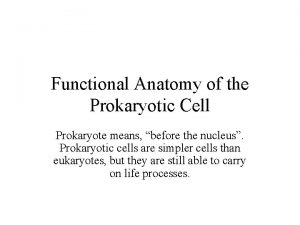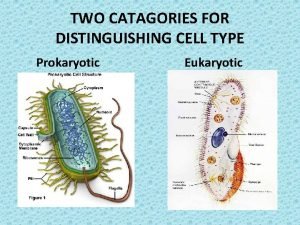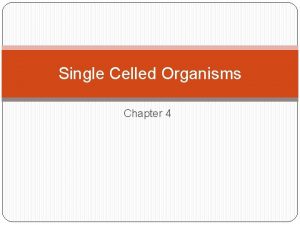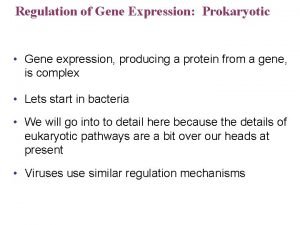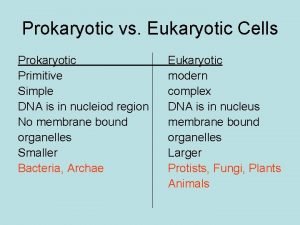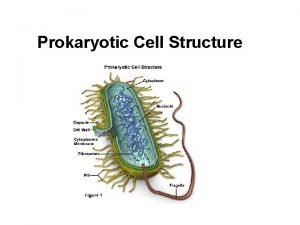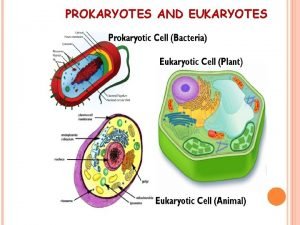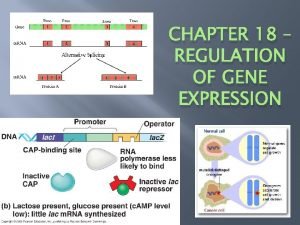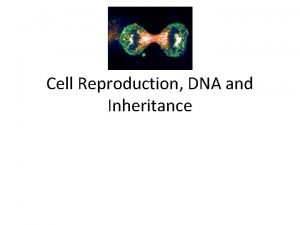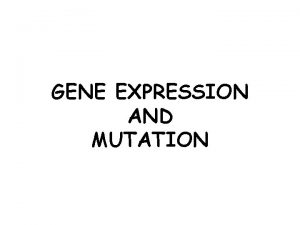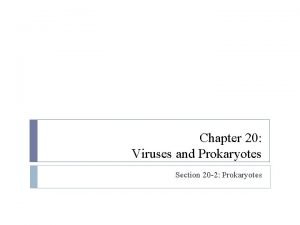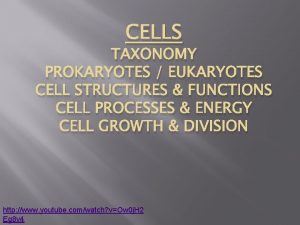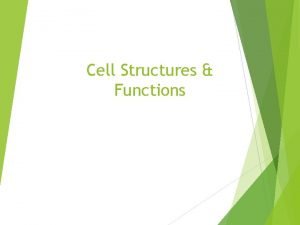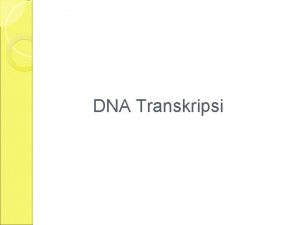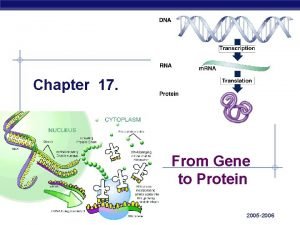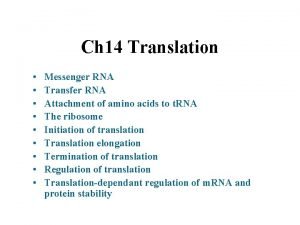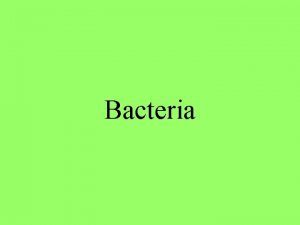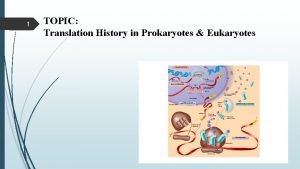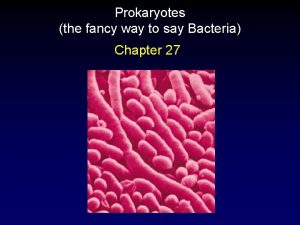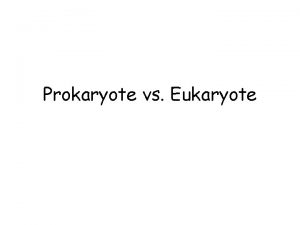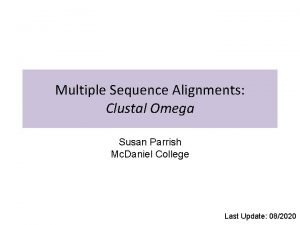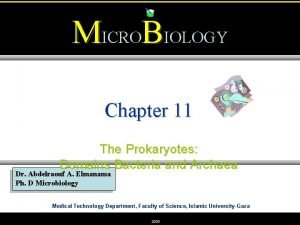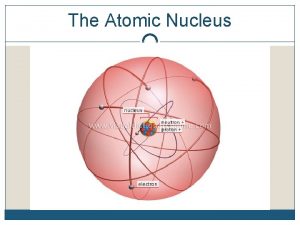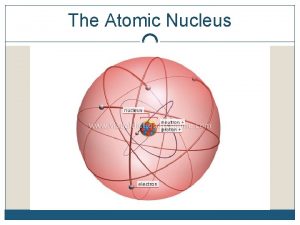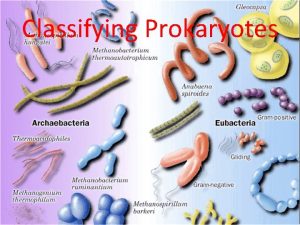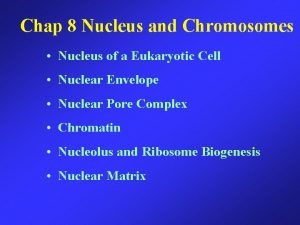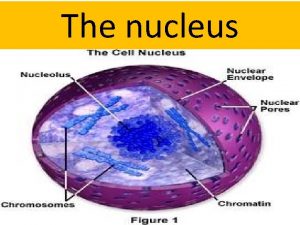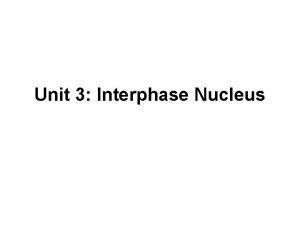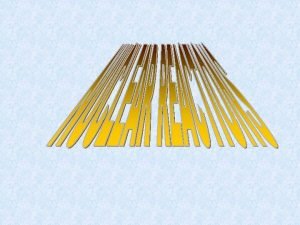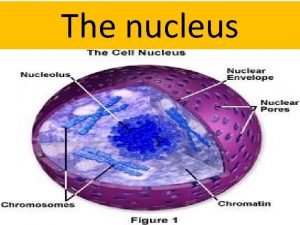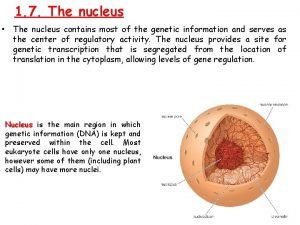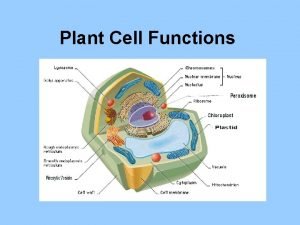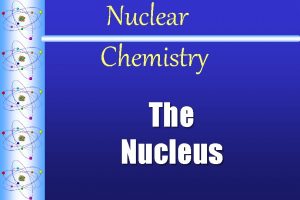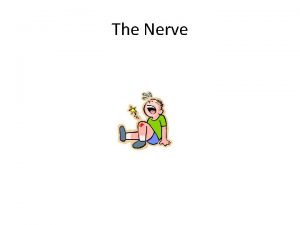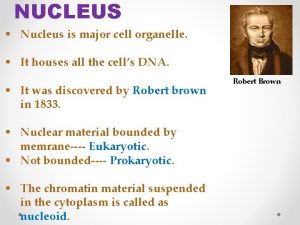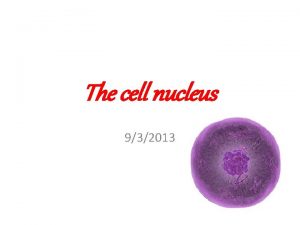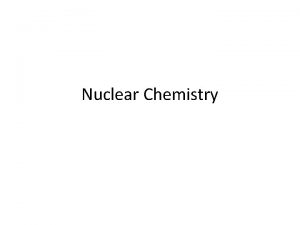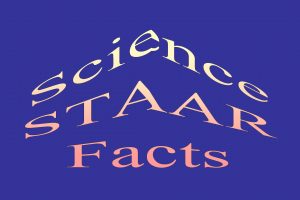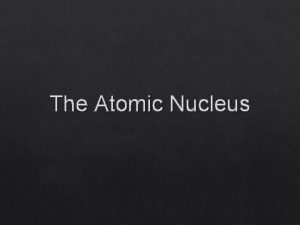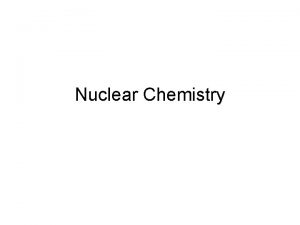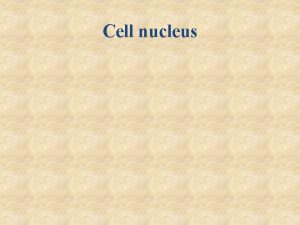PROKARYOTES I Characteristics of Prokaryotes 1 NO NUCLEUS






























- Slides: 30

PROKARYOTES


I. Characteristics of Prokaryotes 1. NO NUCLEUS 2. Organized by their need for oxygen. a) Obligate anaerobe -dies in the presence of oxygen b) Obligate aerobes -need oxygen c) Facultative aerobes- doesn’t need oxygen, but oxygen wont kill it.

I. Characteristics of Prokaryotes 3. Prokaryotes are classified by their shape. Bacillus- rod shaped Coccus- sphere shaped Spirillius- spiral shape

I. Characteristics of Prokaryotes 4. Prokaryotes may group together a) diplo- groups of 2 b) strepto- chains c) staphylo- grapelike clusters.


Names are based on shape & grouping • What is this prokaryotes name?

Names are based on shape & grouping • What is this prokaryotes name? Streptococcus

II. Structure of Prokaryotes 1. Microscopic b/c unicellular 2. No Nucleus, No membrane bound organelles 3. Contains protein making ribosomes. 4. Single, circular chromosome in ‘nucleoid region’

II. Structure of Prokaryotes 5. Plasmids- DNA fragments in cytoplasm 6. Cell wall –protection/support, made of peptidoglycan 7. flagella/cilia- movement (1 many flagella) 8. May have a sticky coating called a capsule for attachment to host cells or other bacteria.


III. Types of Prokaryotes 1. Archaea a) b) c) d) Most ancient/primitive type of bacteria. Live in very harsh environments Have NO peptidoglycan in it’s cell wall Gram negative 2. Eubacteria a) Most numerous bacteria on earth. b) Most likely to encounter eubacteria c) LOTS of peptidoglycan in cell wall d) Gram positive

IV. Variety in Prokaryotes • Photoautotroph-near surface to receive sunlight • chemoautotroph- make food from chemicals; found in oceans around hydrothermal vents • Nitrogen fixing- converts N gas into nitrates, a form of N plants can use. • Halophiles – live in extremely salty environments • Thermophiles- live in extremely hot or cold environments • Decomposers-break down dead stuff • Methanogens- digestive tract of animals.

IV. Variety in Prokaryotes Chemoautotrophs-A Halophiles-A

IV. Variety in Prokaryotes Thermoacidophiles-A Nitrogen Fixing-E

IV. Variety in Prokaryotes Methanogens(Archaea): create methane as a byproduct.

V. Reproduction/Survival Methods • Binary fission- asexual reproduction, 2 identical cells. • Conjugation- DNA is exchanged through a pili connecting bridge. • Endospore- protective coat that allows for their survival in unfavorable conditions (lies dormant until conditions are favorable again. )

Binary Fission




VI. How do Bacteria help us? 1. Symbiotic relationships: E coli in intestinal tract makes vitamin k for us. 2. Fermentaion: produces yogurt, cheese, pickles, soy sauce. 3. Decomposers: putting N, c, H, H back into the soil for use by another organism. 4. Bioremediation-using bacteria to clean oil spills and other pollutants. 5. Making of drugs- insulin is produced in a lab via manipulating the DNA of common bacterium.

VII. How do bacteria harm us? • Some prokaryotes release toxins that destroy cells. As prokaryotes reproduce quickly, the toxin builds up in the body until the organism becomes sick overall.

VIII. How to prevent bacteria infections? • Antibiotics: break down bacterial cell walls. • Store and cook meats correctly. • Keeps hands clean and away from your face. (eyes, nose and mouth are easy places for bacteria to enter you. )

Note about antibiotics: • Overuse of antibiotics leads to bacterial resistance of the antibiotic. • Plasmids are easily mutated then shared via conjugation. • Leads to generations of bacteria which are no longer killed by the antibiotic. • Only use antibiotics when absolutely necessary.

IX. How do you know which bacteria has made you sick and what treatment to pursue? • Gram Staining will help identify which type of bacteria has infected you and what course of treatment will rid you of them. • Bacteria are treated with purple Crystal Violet and red Safranin stains. • Cell walls will either stain purple or reddish pink depending on the composition of the cell wall.

Gram Staining and Cell Walls Gram Positive (+) bacterium Gram Negative (-) bacterium


Gram Positive (+) • Have a THICK layer of peptidoglycan in cell wall. • Peptidoglycan absorbs the purple dye easily. • CAN be treated with antibiotics.

Gram Negative (-) • Have THIN layer of peptidoglycan in cell wall. • Purple stain is not absorbed, red Safranin is. • Cell wall with turn pink. • Much harder to treat with antibiotics.
 Characteristics prokaryotic cells
Characteristics prokaryotic cells What are two distinguishing characteristics of prokaryotes
What are two distinguishing characteristics of prokaryotes Prokaryotes that break down dead organisms
Prokaryotes that break down dead organisms Operon lac
Operon lac Gene structure prokaryotes vs eukaryotes
Gene structure prokaryotes vs eukaryotes Are amoeba prokaryotic or eukaryotic
Are amoeba prokaryotic or eukaryotic Prokaryotes vs eukaryotes venn diagram
Prokaryotes vs eukaryotes venn diagram Mesosomes function
Mesosomes function Abdomina
Abdomina Are red blood cells prokaryotic
Are red blood cells prokaryotic Nonliving particle that replicates inside a living cell
Nonliving particle that replicates inside a living cell Prokaryotes vs eukaryotes gene regulation
Prokaryotes vs eukaryotes gene regulation Cloroplasto
Cloroplasto Microscope onion root tip mitosis
Microscope onion root tip mitosis Diff between prokaryotes and eukaryotes
Diff between prokaryotes and eukaryotes Chapter 20 viruses and prokaryotes
Chapter 20 viruses and prokaryotes King phillip came over from great spain
King phillip came over from great spain Cytoskeleton nickname
Cytoskeleton nickname Diff between prokaryotes and eukaryotes
Diff between prokaryotes and eukaryotes Prokaryotic versus eukaryotic
Prokaryotic versus eukaryotic Termination of transcription in prokaryotes
Termination of transcription in prokaryotes Transcription in prokaryotes
Transcription in prokaryotes Proofreading
Proofreading Unicellular prokaryotes kingdom
Unicellular prokaryotes kingdom Elongation of translation in prokaryotes
Elongation of translation in prokaryotes Translation prokaryotes
Translation prokaryotes How to say prokaryotes
How to say prokaryotes Prokaryotes domain
Prokaryotes domain Prokaryotes vs eukaryotes
Prokaryotes vs eukaryotes Clustal omega alignment
Clustal omega alignment Microbiology chapter 11
Microbiology chapter 11
